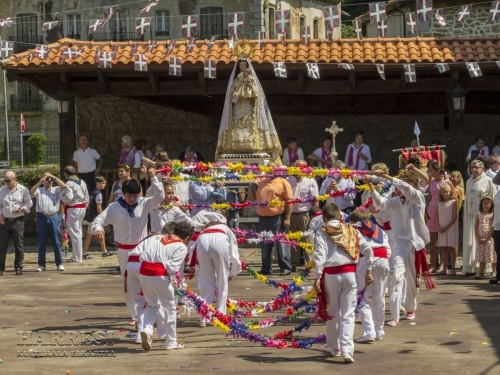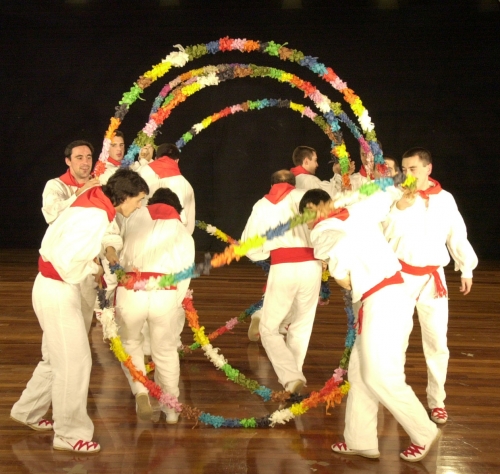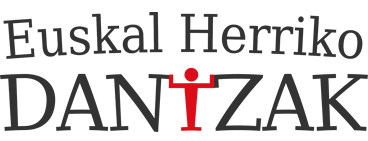The peculiar "switch" dance of lanestosa, the only one of its kind in Bizkaia
- Emilio Xabier Dueñas
- 15/ 10/ 2001
Traditional (ahem) folklore, conceptually bunches together a series of customs and traditions that have either been somewhat sporadically maintained, or have been recovered or even reconstructed.

Under each of these headings regarding folklore, traditional Dance has served, for so many generations that they have become lost with the centuries, first of all as a fundament of bodily expression, without forgetting their ritual origins (preceded as well as created). It has also served as a way of increasing relations between the sexes, as well as a way of getting some physical exercise, and satisfying the need to "stand out" in some way by demonstrating one's abilities. Even today, all of these things continue to function in the same way, although now with different parameters.
Many types of traditional dances have come into existence throughout our geographic territory. Most of those that have been preserved, according to their historic origins, as belong to the ranks of male dances, or at least, they are carried out and directed by males, although there are certainly dances for women, as well as those in which they take part to varying degrees. Of all of these, the only one traditionally performed in the Bizkaian county of Encartaciones/Enkarterriak, is the "Switch Dance", from the border area of Lanestosa. This town is located in the midst of an incomparably beautiful landscape, and whose center is home to admirable houses and stately homes. Every year, on the 5th of August, the entourage runs through the cobble-stoned streets, reviving a unique religious celebration.
The present: out of the past
Historic accounts relating to festivities in the town go back to the 17th century, when the Carnival, Holy (Easter) Week, and the feast-days of patron saints, with their music and dance, occupied a privileged place for the various writers of the day, who discreetly penned their testimonies of the vicissitudes of eras gone by.
The figures of the drummer, pipers and dancers, mentioned by their full names in texts dating from the mid-19th century, make us take note of the fact that they were all from the same village, and that they wore costumes that have changed very little since the end of said period: a "zorongo"-type neck-kerchief, identical to those found in the southern part of the country, and a ring through which were threaded the corners of the other kerchief hung about the neck. These were, according to written and oral accounts, the only small differences from today's costumes, except for their actual fabric, although colors for the outfit would be have been white for the shirt, trousers and hemp slippers, red for the ribbons and sash or waistband, with kerchiefs of differing colors.
The implements used in the dance were long wands or switches made of "zarzarraya" or hawthorn, which had been cut during the previous evening and bound with multi-colored tissue paper or a similar material. These are the main element for carrying out all the different parts of the dance, with a formation of two rows (with the "captain" at front-and-center), or two interlacing rows. These two positions are known as "open" and "closed".
Over time, the dancing figure has taken on a new value: before, there were 9 dancers, but there are now many more, as well as additional children's groups. Performances stretch beyond the territorial bounds of the town, and their choreographic capacity is greater, partly owing to its members becoming integrated into this or other Basque dance groups.
The "Switch Dance" is found in a geographic area that covers not only certain parts of the Peninsula, but also North, Central and Southern Europe. Dances using wands or flowering, bowed sticks exist not many kilometers away from Lanestosa, in Cantabria, and also in Euskal Herria, where they are known as Uztai haundi and Uztai txiki of Gipuzkoa, the Arku Dantzak of Iurreta and Oinati, or the "Boe Dance" of Monteagudo. Also, part from the natural materials of the utensils used, the sword formations of the Ezpata Dantza of Xemein, the Alkate Dantza of Lakuntza, the Makil gurutze Dantza of Lesaka, or the Bordon Dantza of Tolosa, share similarities that cannot escape the observant eye of the researcher, such as choreographic forms with various interlacing figures, "bridges", etc.
The spacial framework: the "fiesta"
The recent folkloric/festive calendar of the town is actually somewhat subdued, but the few celebrations that are still held during the year, as well as those that have recently been created, lift the spirits of the inhabitants, and the streets definitely brighten up during those days.

Among all of these celebrations, the most outstanding is that commemorating "Our Lady of Las Nieves (lit. the snows)", which, on the 5th of August for the past three centuries, keeps the "flame of the Dance" alive (as its popular name had been up until a few years ago, even more so enthusiastically so among the town's young people).
Looking at the most traditional aspects of these festivities, and taking into account the substantial changes in physiognomy that the town undergoes, from the peaceful silence of its streets to a state of noisy merriment, the dancers begin to gather during the first hours of the morning. Each year, their number is greater, and the last dress rehearsal takes place before the official performance, immediately after which their mission will be to round up members of the civil authorities and transport them to the parish church, where full mass will be said.
Once the mass is over, those present in the procession, including the image of the Virgin, along with the dancers who weave back and forth, the musicians, members of the city hall, church and town representatives, all travel the town's central streets, accompanied by the thunder of Roman candles and the tolling of temple bells.
The itinerary takes them to the square, where there will be an individual Aurresku dance, a Salve is said, and the "Dance" is performed by a group of local children, who also take a secondary part in the procession. Upon returning to the church, the mayor's and city councilors' escort to the city hall, along with an invitation to the dancers on behalf of the city to refresh themselves in bars or taverns, bring a close to the morning's activities.
In the afternoon, after a sumptuous meal, it is time for the "collection". This time, the dance is performed casually from door to door, while cheers are shouted to residents, their families, friends and neighbors, in exchange for donations of money and warm invitations to refreshment, liqueurs, and sweets.
It is a long day, even for those who were not up the night before. The dancers, enraptured by their efforts, share out the money earned with the musicians, and then go home to supper. Some hours later, somewhat recovered, many go out again with a new burst of energy to the streets or the town square, where the festivities make even the "rustiest" bodies begin to move.
People's attitudes to the festival vary, according to age. During celebration days, the population grows immensely, especially during the summer. Many families live in other villages or in the capital, Bilbao. Native sons of the town, and their children and grandchildren, come to spend their vacations days in this little corner of Bizkaia, which now has become known through the media, and whose importance during the Middle Ages can be seen in the fact that it was given a town charter, as well as in its architecture, since it was a trade center.
Year after year, the ritual has very gradually been changing, something that will only become noticeable after much time has gone by. The festivities' schedule, protagonists, order of events, and the introduction of new components take over past little by little, making it continually revive and transform itself. This is, indeed, a traditional festival that is just as idiosyncratic as it is unique.








